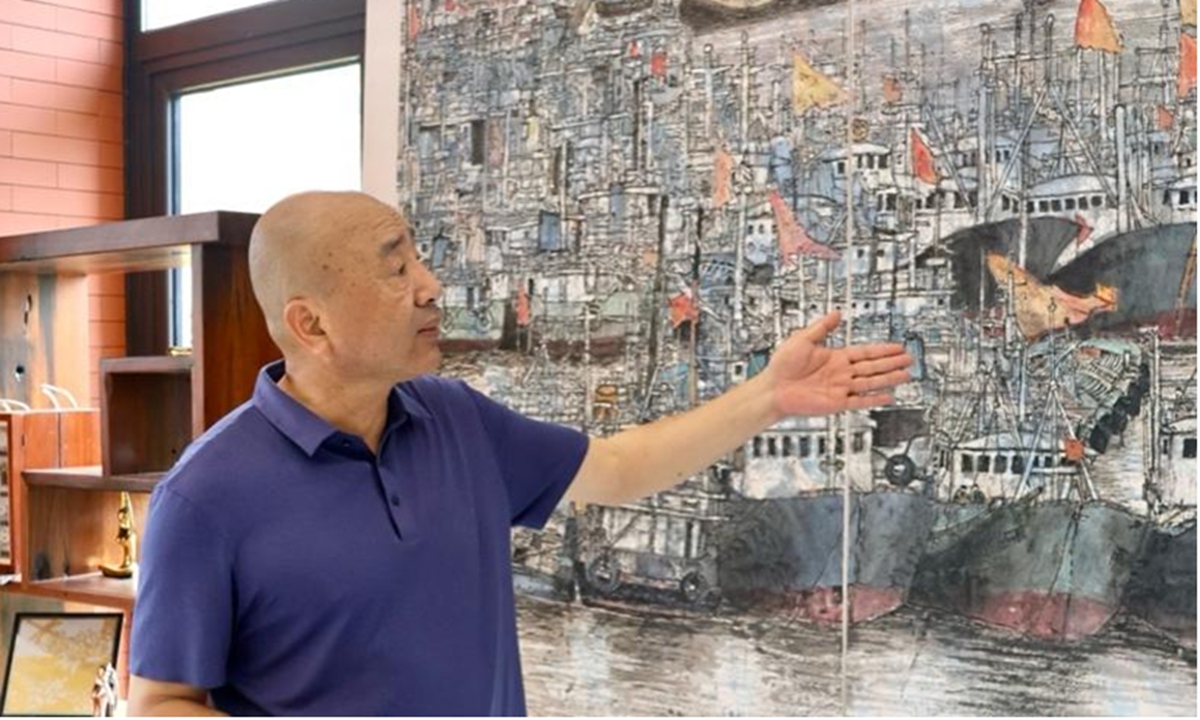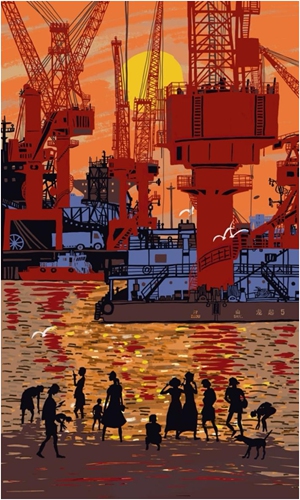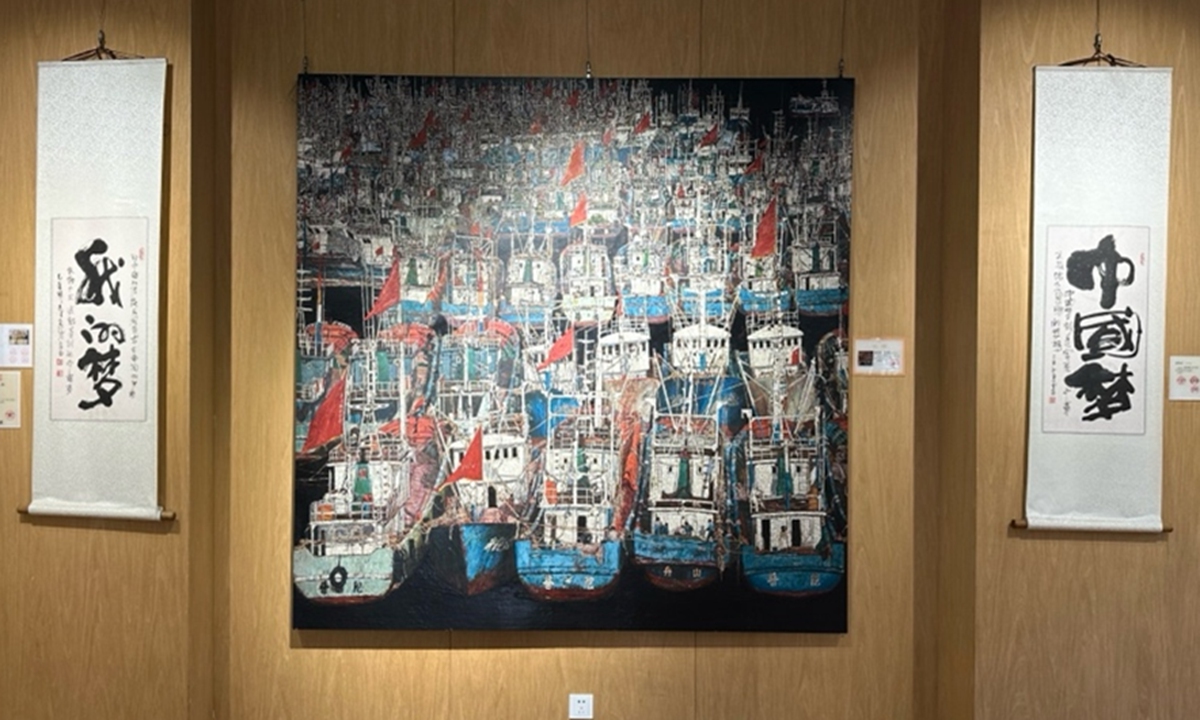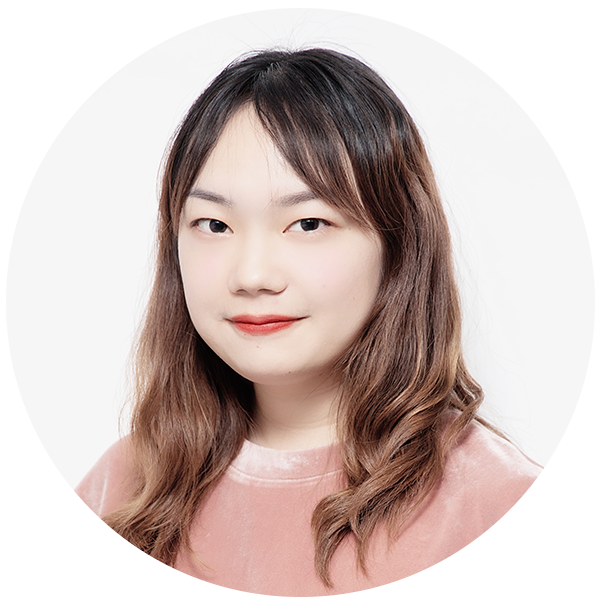
Artist Zhang Gaojun introduces his Chinese painting “Fishing Capital in the Rain,” in Zhoushan, East China’s Zhejiang Province, on June 28, 2024. Photo: Zhang Yang
With summer holidays approaching, Zhang Gaojun's schedule is packed to the brim. At an art gallery in Xinjian village in Zhoushan, an island city in East China's Zhejiang Province, he is busy welcoming a large number of tourists as well as hosting various workshops on paper-cutting and paintings of fishermen.
Nine years ago, during an inspection tour to Xinjian, Chinese President Xi Jinping stepped into Zhang's art gallery and showed interest in the intricate process of lacquer painting creation.
"These paintings of fishermen are very charming and have a unique flavor. You've done something meaningful," Xi told Zhang. This encouragement remains vivid in Zhang's memory.
Following in the president's footsteps, the Global Times visited the beautiful village to meet the renowned artist, who shared his unforgettable encounter with the Chinese president as well as how he was inspired to devote himself to painting fishermen and to explore a path that could lead the island villagers to prosperity.
Today, Xinjian village has developed a characteristic island folk art style that has become a remarkable calling card. Island dwellers are also increasingly realizing that folk art not only attracts a continuous stream of visitors, but also weaves cultural vitality into their rural revitalization efforts.

Zhang Gaojun’s paper-cut painting “Great Port in The East” Photo: Courtesy of Zhang Gaojun
Charming art gallery in island village
Wandering through Xinjian village, visitors can see white walls and black tiles that complement each other perfectly, along with wooden windows carved with patterns and fisherman murals that can be seen everywhere.
The Rural Art Gallery of Xinjian village, formerly known as the "Archipelago Art Gallery," which stands as the first island gallery in the village of Zhoushan, displays a variety of art pieces, each exuding the vibrant essence of island life.
Among these works are Zhoushan's characteristic paintings of fishermen, exquisite lacquer crafts, and modern paper-cut works.
"These pieces vividly show scenes of fishermen's daily work, coastal traditions, and island folklore. They are created by amateur painters," Zhang told the Global Times. "Since they are familiar with the fishermen's living conditions and working scenes, their artworks are more vivid and touching."
One of Zhang's paintings, called "Fishing Capital in the Rain," shows a scene of fishing boats moored at the jetty during the closed fishing season in Shenjiamen Fishing Port, which has a history of more than 600 years.
"When President Xi saw my paintings, he said they had a touch of Picasso's style," Zhang said. "I was so surprised! When President Xi was about to leave, he suddenly turned back just to give me a thumbs-up. That gesture meant the world to me."
Beside the square of Xinjian stands a wall with a 60-meter-long mural on it, picturing the entire process of rice cultivation, from the initial planting to the bountiful harvest.
Collaborating with local artists, Zhang has painted the exterior walls of 33 village houses with vibrant murals depicting farming, maritime culture, traditional festivals, and childhood memories.
In addition to paintings of fishermen, the gallery also displays paper-cut artworks, which reflect the original artistic style of Zhoushan. Unlike traditional paper-cutting, modern Zhoushan paper-cutting incorporates techniques from printmaking, layering multi-colored papers together to create patterns.

Zhang Gaojun’s lacquer painting “Closed Fishing Season” is flanked by calligraphy pieces of “the Chinese Dream, my dream.” Photo: Sun Haihan
Folk art as an engine for rural revitalization
"There used to be few visitors to our village. It was a major concern for us. We tried so hard to find our path toward prosperity but in vain. Then, after the president's visit in 2015, it clicked: We could use paintings of fishermen and paper-cutting art as our way out. That's when we decided to establish a base here for students from art schools to collect inspiration," Zhang said.
For over years, Zhang collaborated with professors of art schools across the country, inviting students to experience distinctive local customs and culture. Hundreds of students came here to gather materials beneficial for creation and stayed for one to two weeks. The students took photos and shared them on social media, thus putting the village on the map as a popular sightseeing destination. By now, Xinjian has served as a practice base for students from over 20 art schools nationwide.
Xinjian's distinctive island art atmosphere has also attracted artists from overseas. A Russian painter stayed in the village for eight months to learn the artistic styles and techniques of Zhoushan paintings of fishermen. Drawing inspiration from the village's natural scenery and social customs, the Russian artist crafted his works, capturing the essence of the community's daily life and traditions.
"After living here for a period of time, the Russian artist began to embrace the Zhoushan lifestyle, and even picked up some of the local dialect," Zhang said, with a bright smile.
With the development of artistic undertakings in Xinjian, this once remote and little-known island village has now become a destination where a far wider range of people can appreciate its natural charm and artistic beauty.
"In 2023, the village welcomed over 600,000 tourists, triple the figure of 2014, the year before President Xi's visit," said Ge Linlu, the advocacy officer of Xinjian. Seizing this opportunity, Xinjian villagers benefited by earning extra income through providing various services for tourists, such as cafes and bookstores. The village now has over 40 farmhouse restaurants and 12 countryside inns, creating more than 100 employment positions.
According to the official website of Zhoushan Government, in 2023, Xinjian's total income soared to 85 million yuan ($11.72 million), with the per capita disposable income of villagers reaching 49,009 yuan ($6,760) - a remarkable 50.6 percent increase from 24,200 yuan ($3,338) in 2014.
"Only if each of us contributes our utmost to society, can the rejuvenation of the Chinese nation be achieved. As for me, my dream is to use art to fuel rural revitalization. This is my way to make the 'Chinese Dream' come true," Zhang said.
Sun Haihan, Teng Ruibei, Zhang Yue, Luo Yiwen, Jia Jiahao, and Zhang Yang from the Communication University of China contributed to this story

